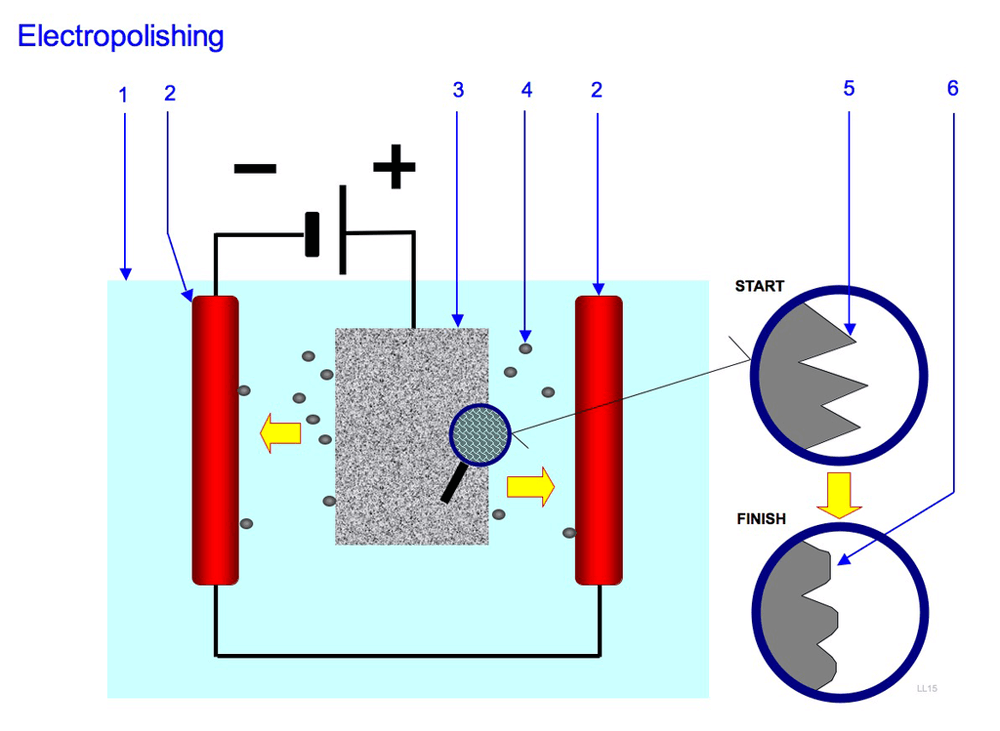Electropolishing vs Mechanical Polishing
Updated: May 05, 2024
The main difference is that mechanical polishing uses abrasives to treat a single part. At the same time, electropolishing uses electrolytes and direct current to remove the external surface of many parts simultaneously. Both processes are intended to ensure an excellent surface finish of metal components.
We describe mechanical polishing and electropolishing in detail, compare them, and reveal their main differences.
1. What is Electropolishing?
Let’s start by examining the more complex concept – electropolishing. This finishing process is based on electrochemical reactions.
A workpiece is immersed In the bath with the electrolyte (sulfuric acid or phosphoric acid). In this case, a metal part serves as a positively-charged anode. At the same time, the negatively charged cathode is typically presented with stainless steel or zirconium.
After exposure of direct electrical current to the bath, metal ions from the surface of metal parts begin to dissolve in completely controlled amounts. It results in the micron-level thickness of surface removal.

The features of electropolishing are numerous and are not limited to the following:
- Electropolishing enhances corrosion resistance, making surfaces of components less vulnerable to oxidation.
- Electropolishing eliminates jagged edges smoothing surfaces overall.
- Electropolishing achieves extra precision of finishing.
- Electropolishing removes oxide scale and heat tint.
2. What is Mechanical Polishing?
In its turn, mechanical polishing is simply a three-stage process intended to produce high-quality surface smoothness using mechanical abrasives.
Types of mechanical polishing are:
- Abrasive belt polishing
- Abrasive wheel polishing
- Polishing with automated and hand polishing equipment
- Customer machinery for polishing of tubular workpieces.

Typically, the polishing starts with grinding – a shearing process intended to remove excessive amounts of material on surfaces roughly. For this purpose, grinding wheels and coated abrasive belts were used.
Then, the process continues with polishing itself. It is the improvement of surface finish by using high pressure and temperatures to melt peaks in the metal and make them fill scratches. In the process, the material is not removed but only partially melted and spread over the surface to achieve smoothness.
The process ends with buffing, intended to enhance the aesthetics of the material. For instance, by making a metal mat or giving it a mirror-like finish. Cotton buff and polishing compounds are typically used to ensure surface appearance improvement.
The features of electropolishing are the following:
- Polishing reduced product adhesion.
- Polishing enhances surface cleanability making it easy to maintain workpieces clean.
- Polishing improves the aesthetic appearance of workpieces.
- Polishing enhances the overall quality of the material surface and assists in achieving precise dimensions of components.
3. Differences Between Electropolishing and Mechanical Polishing
These finishing processes significantly differ, complicating the decision to choose a finishing method.
Scope of Application
Electropolishing is intended for a range of materials, including:
- Stainless steel
- Aluminum and its alloys
- Carbon steels
- Copper alloys
- Nickel alloys
- Titanium
- And others less widespread.
This process is used to create such types of equipment as: heat exchangers, storage tanks for various industries, clean rooms for pharmaceutical manufacturers, food processing tools, medical tools, vehicle parts, and others.
Mechanical polishing can be applied to almost any metal, so there is no need to reference all suitable materials here.
This process is used in such industries as food, pharmacy, automobile, and cosmetic ones. And it is intended to create such types of equipment as: architectural metal, cookware, metal automobile parts, office furniture, fittings, and others.
Cost
It is a tricky question, an answer to which depends on various factors. Typically, electropolishing is regarded as a more technologically advanced process, which requires high-cost equipment, materials, and skilled labor.
As a result, the cost of polishing one random metal part is significantly higher in electropolishing rather than in mechanical polishing. However, it is never that only one part is treated in one run.
At the same time, mechanical polishing is a labor and time-consuming process, the quality of which depends on the proficiency of workers. The more components you require, the less accurate the process becomes, to a certain extent. It is related to processing only one component in one run.
In essence, the costs of finishing a batch of particular components may fluctuate significantly, and the cost-effectiveness of a finishing process may vary from batch to batch.
Surface Finish Quality
Here’s the kicker. Electropolishing is always a more accurate finishing process compared to mechanical polishing. You can cut off the exact amount of material, so dimensions and smoothness are as precise as possible.
Mechanical polishing may ensure excellent smoothness and enhance a workpiece with additional attractiveness. However, the dimensions of a component rely entirely on the proficiency of a worker who performs finishing. This way, consistency is unachievable.
4. Summary
Currently, electropolishing is a more advanced finishing process compared to mechanical polishing. It is more cost-effective in the long run, more controllable, and less labor-dependent. It also supports most common metals and can be automated.
While scopes of applications in these two manufacturing processes are somewhat different, you still can be recommended to use electropolishing if possible.
5. FAQ
5.1 Is electropolishing safe?
Depending on safety precautions taken, electropolishing is regarded as a safer process than mechanical polishing as labor does not directly participate in it.
5.2 Can I use mechanical polishing instead of electropolishing?
You absolutely can replace one finishing process with another in most cases. But, not adhering to standard scopes of applications will likely result either in poor finish quality or impossibility to finish some types of parts.
5.3 Is electropolishing the same as electroplating?
No, these processes are directly opposite, as the first is removing material from a workpiece, while the second is depositing material on a workpiece.